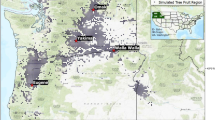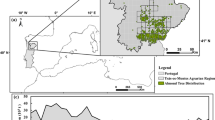Abstract
Increases in temperature as a result of anthropogenically generated greenhouse gas (GHG) emissions are likely to impact key aspects of horticultural production. The potential effect of higher temperatures on fruit and nut trees’ ability to break winter dormancy, which requires exposure to winter chilling temperatures, was considered. Three chill models (the 0–7.2°C, Modified Utah, and Dynamic models) were used to investigate changes in chill accumulation at 13 sites across Australia according to localised temperature change related to 1, 2 and 3°C increases in global average temperatures. This methodology avoids reliance on outcomes of future GHG emission pathways, which vary and are likely to change. Regional impacts and rates of decline in chilling differ among the chill models, with the 0–7.2°C model indicating the greatest reduction and the Dynamic model the slowest rate of decline. Elevated and high latitude eastern Australian sites were the least affected while the three more maritime, less elevated Western Australian locations were shown to bear the greatest impact from future warming.



Similar content being viewed by others

References
Alburquerque N, García-Montiel F, Carrillo A, Burgos L (2008) Chilling and heat requirements of sweet cherry cultivars and the relationship between altitude and the probability of satisfying the chill requirements. Environ Exp Bot 64(2):162–170
Alonso JM, Anson JM, Espiau MT, Company RSI (2005) Determination of endodormancy break in almond flower buds by a correlation model using the average temperature of different day intervals and its application to the estimation of chill and heat requirements and blooming date. J Am Soc Hortic Sci 130(3):308–318
Ashcroft GL, Richardson EA, Seeley SD (1977) Statistical-method of determining chill unit and growing degree hour requirements for deciduous fruit-trees. HortSci 12(4):347–348
Baldocchi D, Wong S (2008) Accumulated winter chill is decreasing in the fruit growing regions of California. Clim Chang 87:S153–S166
Bennett JP (1949) Temperature and bud rest period. Califor Agric 3(11):12
Campoy JA, Ruiz D, Cook N, Allderman L, Egea J (2011a) Clinal variation of dormancy progression in apricot. S Afr J Bot 77(3):618–630
Campoy JA, Ruiz D, Egea J (2011b) Dormancy in temperate fruit trees in a global warming context: a review. Sci Hortic-Amsterdam 130(2):357–372
Campoy JA, Ruiz D, Allderman L, Cook N, Egea J (2012) The fulfilment of chilling requirements and the adaptation of apricot (Prunus armeniaca L.) in warm winter climates: an approach in Murcia (Spain) and the Western Cape (South Africa). Eur J Agron 37(1):43–55
Cesaraccio C, Spano D, Snyder RL, Duce P (2004) Chilling and forcing model to predict bud-burst of crop and forest species. Agric For Meteorol 126(1–2):1–13
Clarke JM, Whetton PH, Hennessy KJ (2011) Providing application-specific climate projections datasets: CSIRO’s climate futures framework. In: Chan F, Marinova D, Anderssen RS (eds) MODSIM2011, 19th International Congress on Modelling and Simulation. Modelling and Simulation Society of Australia and New Zealand, Perth, pp 2683–2690
Darbyshire R, Webb L, Goodwin I, Barlow S (2011) Winter chilling trends for deciduous fruit trees in Australia. Agric For Meteorol 151:1074–1085
Dennis FG (1994) Dormancy - what we know (and don’t know). HortSci 29(11):1249–1255
Eccel E, Rea R, Caffarra A, Crisci A (2009) Risk of spring frost to apple production under future climate scenarios: the role of phenological acclimation. Int J Biometeorol 53:273–286
Erez A, Fishman S, Linsley-Noakes GC, Allan P (1990) The dynamic model for rest completion in peach buds. Acta Hortic 279:165–174
Fishman S, Erez A, Couvillon GA (1987) The temperature-dependence of dormancy breaking in plants - computer-simulation of processes studied under controlled temperatures. J Theor Biol 126(3):309–321
Ghariani K, Stebbins RL (1994) Chilling requirements of apple and pear cultivars. Fruit Varieties J 48(4):215–222
Harrington CA, Gould PJ, St.Clair JB (2010) Modeling the effects of winter environment on dormancy release of Douglas-fir. For Ecol Manag 259(4):798–808
Hennessy K, Clayton-Greene K (1995) Greenhouse warming and vernalisation of high-chill fruit in southern Australia. Clim Chang 30:327–348
IPCC (2007) Climate change 2007: the physical science basis - contribution of working group I to the fourth assessment report of the Intergovernmental Panel on Climate Change. Cambridge University, Cambridge
Jones D, Wang W, Fawcett R (2009) High-quality spatial climate data-sets for Australia. Aust Meteorol Oceanogr J 58:233–248
Jun M, Knutti R, Nychka DW (2008) Spatial analysis to quantify numerical model bias and dependence: how many climate models are there? J Am Stat Assoc 103(483):934–947. doi:10.1198/016214507000001265
Kaukoranta T, Tahvonen R, Ylamaki A (2010) Climatic potential and risks for apple growing by 2040. Agric Food Sci Finland 19(2):144–159
Legave J, Farrera I, Almeras T, Calleja M (2008) Selecting models of apple flowering time and understanding how global warming has had an impact on this trait. J Hortic Sci Biotechnol 83(1):76–84
Linsley-Noakes GC, Allan P, Matthee G (1994) Modification of rest completion prediction models for improved accuracy in South African stone fruit orchards. J South Afr Soc Hortic Sci 4(1):13–15
Linvill DE (1990) Calculating chilling hours and chill units from daily maximum and minimum temperature observations. HortSci 25(1):14–16
Luedeling E, Brown P (2010) A global analysis of the comparability of winter chill models for fruit and nut trees. Int J Biometeorol 55(3):411–421
Luedeling E, Zhang M, Luedeling V, Girvetz E (2009a) Sensitivity of winter chill models for fruit and nut trees to climate changes expected in California’s central valley. Agric Ecosyst Environ 133:23–31
Luedeling E, Zhang M, McGranahan G, Leslie C (2009b) Validation of winter chill models using historic records of walnut phenology. Agric For Meteorol 149:1854–1864
Luedeling E, Zhang MH, Girvetz EH (2009c) Climatic changes lead to declining winter chill for fruit and nut trees in California during 1950-2099. PLoS One. doi:10.1371/journal.pone.0006166
Luedeling E, Blanke M, Gebauer J (2009d) Auswirkungen des Klimawandels auf die Verfügbarkeit von Kältewirkung (Chilling) für Obstgehölze in Deutschland (Climate change effects on winter chill for fruit crops in Germany). Erwerbs-Obstbau 51:81–94
Luedeling E, Girvetz EH, Semenov MA, Brown PH (2011a) Climate change affects winter chill for temperate fruit and nut trees. PLoS One 6(5)
Luedeling E, Kunz A, Blanke M (2011b) Mehr Chilling für Obstbäume in wärmeren Wintern? (More winter chill for fruit trees in warmer winters?). Erwerbs-Obstbau 53:145–155
Mankotia MS, Chauhan PS, Sud A (2004) Estimation of effective chilling hours and GDH degree C requirement and its significance in predicting full bloom in delicious apple. In: Jindal KK, Sharma RC, Rehalia AS (eds) Proceedings of the Viith International Symposium on Temperate Zone Fruits in the Tropics and Subtropics. Acta Hortic 662: 83-86
Marshall NA, Stokes CJ, Howden SM, Nelson RN (2010) Enhancing adaptive capacity. In: Howden M, Stokes C (eds) Adapting agriculture to climate change: preparing Australian agriculture, foresty and fisheries for the future. CSIRO, Melbourne
Meinshausen M, Meinshausen N, Hare W, Raper SCB, Frieler K, Knutti R, Frame DJ, Allen MR (2009) Greenhouse-gas emission targets for limiting global warming to 2 degrees C. Nature 458(7242):1158–1196
Nakicenovic N, Swart R (eds) (2000) IPCC special report on emission scenarios. Cambridge
Oukabli A, Bartolin S, Viti R (2003) Anatomical and morphological study of apple (Malus X domestica Borkh.) flower buds growing under inadequate winter chilling. J Hortic Sci Biotechnol 78(4):580–585
Page CM, Jones D (2001) OzClim: The development of a climate scenario generator for Australia. In: Zerger A, Argent RM (eds) MODSIM 2001 International Congress on Modelling and Simulation, Modelling and Simulation Society of Australia and New Zealand
Perez FJ, Ormeno JN, Reynaert B, Rubio S (2008) Use of the dynamic model for the assessment of winter chilling in a temperature and a subtropical climatic zone of Chile. Chil J Agric Res 68:198–206
Petri JL, Leite GB (2004) Consequences of insufficient winter chilling on apple tree bud-break. In: Jindal KK, Sharma RC, Rehalia AS (eds) Proceedings of the Viith International Symposium on Temperate Zone Fruits in the Tropics and Subtropics. Acta Hortic 662: 53-60
Petri JL, Berenhauser Leite G, Putti GL (2008) Apple tree budbreak promoters in mild winter conditions. In: Webster AD, Palta J, Lee Y, Lee JM (eds) Proceedings of the International Symposium on Endogenous and Exogenous Plant Bioregulators. Acta Hortic 774:291-295
Ramírez L, Sagredo KX, Reginato GH (2010) Prediction models for chilling and heat requirements to estimate full bloom of almond cultivars in the Central Valley of Chile. Acta Hortic 872:107–112
Richardson EA, Seeley SD, Walker DR (1974) A model for estimating the completion of rest for redhaven and elberta peach trees. HortSci 9(4):331–332
Ricketts JH, Page CM (2007) A web based version of OzClim for exploring climate change impacts and risks in the Australian Region. Modsim 2007: International Congress on Modelling and Simulation - Land, Water and Environmental Management: Integrated Systems for Sustainability. University of Western Australia, Nedlands
Robinson B (1998) Pistachios. In: Hyde KW (ed) The new rural industries: a handbook for farmers and investors. Rural Industries Research & Development Corporation
Ruiz D, Campoy J, Egea J (2007) Chilling and heat requirements of apricot cultivars for flowering. Environ Exp Bot 61:254–263
Saure MC (1985) Dormancy release in deciduous fruit trees. Hortic Rev 7:239–300
Shaltout AD, Unrath CR (1983) Rest completion prediction model for Starkrimson Delicious apples. J Am Soc Hortic Sci 108(6):957–961
Sheard AG, Johnson SD, Cook NC (2009) Effect of timing and concentration of rest breaking agents on budburst in ‘Bing’ sweet cherry under conditions of inadequate winter chilling in South Africa. S Afr J Plant Soil 26(2):73–79
Smith I, Chandler E (2010) Refining rainfall projections for the Murray Darling Basin of south-east Australia—the effect of sampling model results based on performance. Clim Chang 102:377–393
Sunley RJ, Atkinson CJ, Jones HG (2006) Chill unit models and recent changes in the occurrence of winter chill and spring frost in the United Kingdom. J Hortic Sci Biotechnol 81(6):949–958
Suppiah R, Hennessy K, Whetton PH, McInnes K, Macadam I, Bathols J, Ricketts J, Page CM (2007) Australian climate change projections derived from simulations performed for the IPCC 4th Assessment Report. Aust Meteorol Mag 56(3):131–152
Topp BL, Sherman WB (2000) Breeding strategies for developing temperature fruits for the sub-tropics, with particular reference to Prunus. Acta Hortic 522:235–240
van Oldenborgh GJ, Philip SY, Collins M (2005) El Nino in a changing climate: a multi-model study. Ocean Sci 1:81–95
Viti R, Andreini L, Ruiz D, Egea J, Bartolini S, Iacona C, Campoy JA (2010) Effect of climatic conditions on the overcoming of dormancy in apricot flower buds in two Mediterranean areas: Murcia (Spain) and Tuscany (Italy). Sci Hortic-Amsterdam 124(2):217–224. doi:10.1016/j.scienta.2010.01.001
Voller CFP (1986) Predicting rest-breaking: Principles and problems. Decid Fruit Grow 36(8):302–308
Wand SJE, Steyn WJ, Theron KI (2008) Vulnerability and impact of climate change on pear production in South Africa. In: Webster ADOCM (ed) Proceedings of the Xth International Pear Symposium, Vols 1 and 2. Acta Hortic 800:263-271
Watterson IG (2011) Understanding and partitioning future climates for Australian regions from CMIP3 using ocean warming indices. Clim Chang 111:903–922. doi:10.1007/s10584-011-0166-x
Webb L, Whetton PH (2010) Horticulture. In: Howden M, Stokes C (eds) Adapting agriculture to climate change: preparing Australian agiculture, foresty and fisheries for the future. CSIRO, Melbourne
Weinberger JH (1950) Chilling requirements of peach varieties. Proc Am Soc Hortic Sci 56:122–128
Zhang J, Taylor C (2011) The Dynamic model provides the best description of the chill process on ‘Sirora’ pistachio trees in Australia. HortSci 46(3):420–425
Acknowledgements
The authors thank the Australian Bureau of Meteorology for providing the historical data, and QCCCE and CSIRO for the projection data used in the analysis. Ian Smith (BOM), Kevin Hennessy (CSIRO) and Jim Ricketts (QCCCE) also provided valuable advice on data and methodology.
Author information
Authors and Affiliations
Corresponding author
Rights and permissions
About this article
Cite this article
Darbyshire, R., Webb, L., Goodwin, I. et al. Impact of future warming on winter chilling in Australia. Int J Biometeorol 57, 355–366 (2013). https://doi.org/10.1007/s00484-012-0558-2
Received:
Revised:
Accepted:
Published:
Issue Date:
DOI: https://doi.org/10.1007/s00484-012-0558-2



